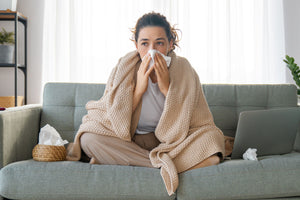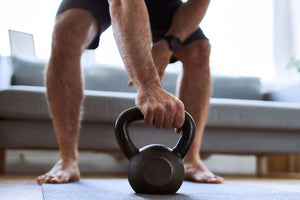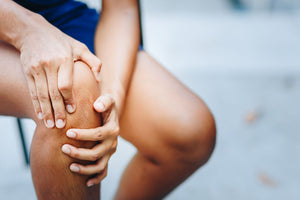The circulatory system is composed of the heart, lungs, and blood vessels, and its role is to deliver oxygen-rich blood throughout the body. It’s also tasked with transporting oxygen-poor blood from the brain and body as well as shuttling metabolic waste away from critical organs and muscles.
Essentially, maintaining optimal circulation is paramount to performance, recovery, and total body health & wellness. However, a number of factors can negatively impact cardiovascular function. Contributing factors to poor circulation include (but aren’t limited to):
- Plaque build-up (which leads to the narrowing of blood vessels
- Physical inactivity (aka a “sedentary” lifestyle)
- Obesity
- High blood pressure
- Smoking
- Heart disease
Here are 7 research-backed ways to optimize circulation.
#1 Exercise Regularly
No surprise here.
We’ve discussed the myriad benefits of regular exercise ad nauseum…heck, we’re a sports nutrition and fitness lifestyle brand! Nevertheless, individuals that may be transitioning from a sedentary lifestyle to a more active one may not understand just how important daily physical activity is -- not only for losing fat and building strength, but also supporting cardiovascular health and optimizing circulation.
Quite simply, exercise is amazing. It increases energy expenditure, supports fat loss, promotes muscle building, counteracts vascular stress, and boosts nitric oxide production.[1,2] Exercise may also reduce the potential of cardiac events.[2]
No matter where you’re starting, regular (daily) physical activity is critical for optimizing your circulation. Walking, jogging, interval training, bodyweight training, weight lifting, etc. -- it all contributes to better cardiovascular health…and numerous other benefits.
If you’re not sure where to start with your exercise plan, the 1UP Fitness App provides customized training programs for FREE.
#2 Self-Myofascial Release (SMR)
Intense exercise (especially in the early days of a new training program) can lead to horrendous muscle soreness, achiness, and a general sense of not wanting to move. But, moderate amounts of physical activity (“active recovery”) can help to reduce soreness, remove toxins, and improve range of motion.
Foam rolling and other self-myofascial release techniques have been found to benefit both athletes and fitness enthusiasts by way of enhancing recovery and improving range of motion.[3]
#3 Dynamic Stretching
Gym class (P.E…”physical education”) is a mainstay of growing up. We’ve all experienced the opening routine of jumping jacks, jogging around the gym, and doing dozens of reps of crunches. After this “warm-up” there’s a seemingly obligatory period of static stretching before embarking on any number of athletic endeavors.
While previous (“old school”) practices embracing warming up and stretching, newer athletic training programs and scientific research indicates that there may be a more optimal way to prime the body for optimal performance -- dynamic stretching.
Dynamic stretching essentially entails moving the body through a full range of motion as opposed to holding a set position for 15, 30, or 60 seconds. In fact, research reviews note that [4]
#4 Massage
Massage (“manual therapy”) is another way to support and optimize your circulation. It increases blood flow and may also help to reduce delayed onset muscle soreness (DOMS). Researchers posit that the mechanical pressure of massage can improve circulation in two key ways -- increasing the arteriolar pressure and increasing muscle temperature from rubbing.[5]
There are several different types of massage, including Swedish, sports, and deep tissue, to name a few. Swedish massages are gentler while deep tissue massages are more intense and can take some getting used to (it’s not uncommon to feel slightly sore after your first few sessions of deep tissue massage, but the benefits are worth it!).
#5 Practice Yoga
A centuries old practice that’s heralded for its relaxation and mindfulness benefits, yoga also can improve circulation. Just as there are many different types of exercise, there are also many different styles of yoga with some being more passive while others are more dynamic, such as power yoga. Regardless, the different poses and flows move your body through space, helping to compress and relax blood vessels, thereby improving circulation. Yoga’s calming effects on the mind also help to reduce blood pressure, further supporting healthy blood flow and cardiovascular health.[6]
#6 Heat Therapy
Heat therapy has long been used for individuals with sore/achy muscles. The reason for this is that applying heat to a specific area of the body can increase blood flow and circulation. While athletes have been utilizing various heat therapies for decades, casual fitness enthusiasts are now starting to recognize the myriad benefits of heat therapy. The most popular heat therapy currently are saunas.
Research notes that regular sauna use can support optimal circulation in a number of different ways, including[7]:
- Increasing cardiac output
- Reducing peripheral vascular resistance
- Decreasing systolic and/or diastolic blood pressure
- Improving flow-mediated vasodilatation of small and/or large blood vessels
Moreover, long-term sauna use is associated with reduced cardiovascular disease risk.
#7 Supplements
In addition to the aforementioned lifestyle habits, certain supplements can also play a role in supporting healthy circulation. At the top of the list are supplements that aid nitric oxide (NO) production. Nitric oxide is an important cell-signaling molecule that performs a number of actions in the body. In regards to circulation, nitric oxide causes vasodilation -- the opening and widening of blood vessels, which supports greater blood flow and nutrient delivery throughout the body.
Two of the best nitric oxide supplements include L-Citrulline and Nitrosigine, both of which can be found in our men’s and women’s pre workouts, 1UP Pre Men & 1UP Pre Women.
Other supplements that have been found to contribute to healthy circulation and cardiovascular health are Omega-3s, curcumin, and niacin.
The Bottom Line
Optimal circulation is the result of living a healthy lifestyle -- eating a nutritious diet, exercising regularly, managing stress, and getting enough sleep. For extra support, check out a few of the circulation support supplements mentioned above and experience the increased energy, mental clarity, and recovery of optimal circulation!
References
- Krzysztofik M, Wilk M, Wojdała G, Gołaś A. Maximizing Muscle Hypertrophy: A Systematic Review of Advanced Resistance Training Techniques and Methods. Int J Environ Res Public Health. 2019 Dec 4;16(24):4897. doi: 10.3390/ijerph16244897. PMID: 31817252; PMCID: PMC6950543.
- Pinckard K, Baskin KK, Stanford KI. Effects of Exercise to Improve Cardiovascular Health. Front Cardiovasc Med. 2019 Jun 4;6:69. doi: 10.3389/fcvm.2019.00069. PMID: 31214598; PMCID: PMC6557987.
- Beardsley C, Škarabot J. Effects of self-myofascial release: A systematic review. J Bodyw Mov Ther. 2015 Oct;19(4):747-58. doi: 10.1016/j.jbmt.2015.08.007. Epub 2015 Aug 28. PMID: 26592233.
- Anderson BL, Harter RA, Farnsworth JL. The Acute Effects of Foam Rolling and Dynamic Stretching on Athletic Performance: A Critically Appraised Topic. J Sport Rehabil. 2020 Aug 13;30(3):501-506. doi: 10.1123/jsr.2020-0059. PMID: 32791495.
- Weerapong P, Hume PA, Kolt GS. The mechanisms of massage and effects on performance, muscle recovery and injury prevention. Sports Med. 2005;35(3):235-56. doi: 10.2165/00007256-200535030-00004. PMID: 15730338.
- Woodyard C. Exploring the therapeutic effects of yoga and its ability to increase quality of life. Int J Yoga. 2011 Jul;4(2):49-54. doi: 10.4103/0973-6131.85485. PMID: 22022122; PMCID: PMC3193654.
- Hussain J, Cohen M. Clinical Effects of Regular Dry Sauna Bathing: A Systematic Review. Evid Based Complement Alternat Med. 2018 Apr 24;2018:1857413. doi: 10.1155/2018/1857413. PMID: 29849692; PMCID: PMC5941775.






